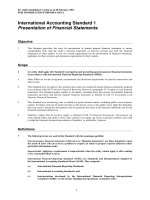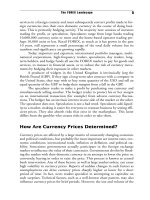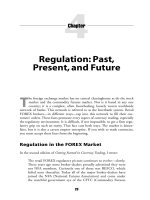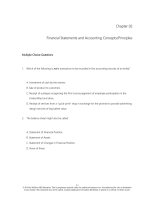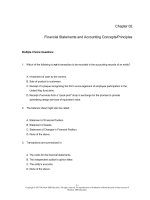Lecture Accounting: What the numbers mean (5/e) - Chapter 8: Accounting for and presentation of owner’ equity
Bạn đang xem bản rút gọn của tài liệu. Xem và tải ngay bản đầy đủ của tài liệu tại đây (149.38 KB, 33 trang )
CHAPTER 8
ACCOUNTING FOR AND
PRESENTATION OF
OWNER’ EQUITY
McGrawHill/Irwin
©The McGrawHill Companies, Inc., 2002
Learning Objectives
• What are the characteristics of common
stock, and how is common stock presented
in the balance sheet?
• What is preferred stock, what are its
advantages and disadvantages to the
corporation, and how is it presented on the
balance sheet?
• How are cash dividends accounted for, and
what are the dates involved in dividend
transactions?
McGrawHill/Irwin
©The McGrawHill Companies, Inc., 2002
Learning Objectives
• What are stock dividends and stock
splits, and why are they used?
• What are the components of “other
comprehensive income,” and why do
these items appear in owners’ equity?
• What is treasury stock, why is it
acquired, and how do treasury stock
transactions affect owners’ equity?
• How are owners’ equity transactions
for the year reported in the financial
statements?
McGrawHill/Irwin
©The McGrawHill Companies, Inc., 2002
Learning Objective 1
• What are the characteristics
of common stock, and how
is common stock presented
in the balance sheet?
McGrawHill/Irwin
©The McGrawHill Companies, Inc., 2002
Owners’ Equity
• The claim of the entity’s owners to the
assets shown in the balance sheet
• Also called net assets
• Owner’s equity for a individual
proprietorship is called proprietor’s capital
• Owners’ equity of a partnerships is called
partners’ capital
• Owners’ equity for a corporation consists
of paid-in capital and retained earnings
McGrawHill/Irwin
©The McGrawHill Companies, Inc., 2002
Paid-In Capital
• Referred to as contributed capital
• Consists of:
– Common stock
– Preferred stock
– Additional paid-in capital
McGrawHill/Irwin
©The McGrawHill Companies, Inc., 2002
Common Stock
• Also called capital stock
• The ultimate owners of the corporation
• Have claim to all assets after all
liabilities and preferred stock claims
have been satisfied
• Have the right and obligation to elect
members of the corporation’s board of
directors
McGrawHill/Irwin
©The McGrawHill Companies, Inc., 2002
Value of Common Stock
• Common stock can have par or no-par
• Par value is the nominal value assigned
to the stock when the corporation is
formed
• Usually a stock cannot be issued for a
value less than par
• Stated value stock is essentially the
same as par value
McGrawHill/Irwin
©The McGrawHill Companies, Inc., 2002
Recording Common Stock
• Par-value common stock sold above par is
recorded as follows:
Cash
Common stock
Additional paid-in capital
XX
XX
XX
• No-par common stock is recorded as follows:
Cash
Common stock
McGrawHill/Irwin
XX
XX
©The McGrawHill Companies, Inc., 2002
Common Stock Disclosures
• Authorized shares of stock represents the
maximum number of shares of stock the
corporation is legally approved to issue
• Issued shares represents the number of
shares of stock that have been transferred
from the corporation to shareholders
• Outstanding shares of stock represents
the shares of stock still in the hands of
shareholders
• Treasury stock represents the difference
between issued and outstanding shares
McGrawHill/Irwin
©The McGrawHill Companies, Inc., 2002
Learning Objective 2
• What is preferred stock, what are
its advantages and disadvantages
to the corporation, and how is it
presented on the balance sheet?
McGrawHill/Irwin
©The McGrawHill Companies, Inc., 2002
Preferred Stock
• Has several debt-like features and a
limited claim on the assets in the event
of liquidation
• Most preferred stock receives a
quarterly or semiannual dividend
• A dividend is a distribution of earnings
of a corporation to its owners
• The amount of the dividend is usually
stated as a dollar amount or as a
percentage (of par value)
McGrawHill/Irwin
©The McGrawHill Companies, Inc., 2002
Preferred Stock Dividends
• A cumulative dividend means that a missed
dividend must be paid before dividends are paid
to common shareholders
• A participating dividend means that after
common stockholders have received a specified
dividend, further dividends are shared by
common and preferred shareholders
• A liquidating dividend is the preferred stock
claim on assets in the event of liquidation
McGrawHill/Irwin
©The McGrawHill Companies, Inc., 2002
Types of Preferred Stock
• Callable preferred stock is redeemable at
the option of the corporation
• Convertible preferred stock may be
exchanged for common stock of the
corporation at the option of the shareholder
at a stated conversion rate
McGrawHill/Irwin
©The McGrawHill Companies, Inc., 2002
Additional Paid-In Capital
• The owners’ equity category that reflects
the excess of the amount received from
the sale of preferred or common stock
over par value
• Also referred to as capital in excess of
par value or capital surplus
McGrawHill/Irwin
©The McGrawHill Companies, Inc., 2002
Retained Earnings
• The retained earnings account reflects
the cumulative earnings of the
corporation that have been retained for
use in the business rather than paid out
as dividends
• Retained earnings are not cash
• The main factors affecting retained
earnings are net income (or loss) and
dividends
McGrawHill/Irwin
©The McGrawHill Companies, Inc., 2002
Learning Objective 3
• How are cash dividends accounted
for, and what are the dates involved
in dividend transactions?
McGrawHill/Irwin
©The McGrawHill Companies, Inc., 2002
Cash Dividends
• To pay a dividend, a corporation must have:
– Sufficient retained earnings
– Sufficient cash to pay the dividend
– A dividend declaration by the board of
directors
• The key dates related to dividends are:
– Date of declaration
– Date of record
– Date of payment
McGrawHill/Irwin
©The McGrawHill Companies, Inc., 2002
Dividend Dates
• Date of declaration is the date the board of
directors declares the dividend
• Date of record is the date used to determine
who receives the dividend – the stockholders
of record as of that date
• Date of payment is the date the dividend
checks are mailed to the shareholders
• Ex-dividend date is three business days
before the date of record – the stock trades
without the dividend
McGrawHill/Irwin
©The McGrawHill Companies, Inc., 2002
Learning Objective 4
• What are stock dividends and stock
splits, and why are they used?
McGrawHill/Irwin
©The McGrawHill Companies, Inc., 2002
Stock Dividends
• The issuance of additional stock to existing
shareholders in proportion to the number of
shares currently owned
• Used to maintain loyalty of stockholders
when the firm does not have enough cash
for a cash dividend
• Affects only owners’ equity of the firm:
Retained earnings
XX
Common stock
XX
Additional paid-in capital
XX
McGrawHill/Irwin
©The McGrawHill Companies, Inc., 2002
Stock Split
• Will lower the market price of a firm’s
stock
• Involves issuing additional share of
stock to existing shareholders
• No accounting entry is required
• The par value and the number of
shares issued changes
McGrawHill/Irwin
©The McGrawHill Companies, Inc., 2002
Learning Objective 6
• What is treasury stock, why is it
acquired, and how do treasury
stock transactions affect owners’
equity?
McGrawHill/Irwin
©The McGrawHill Companies, Inc., 2002
Treasury Stock
• Shares of a corporation’s own stock that
have been purchased from shareholders
• Is reflected on the balance sheet as a
contra owners’ equity account
• Treasure stock is not an asset
• Recorded as follows:
Treasury stock
Cash
McGrawHill/Irwin
XX
XX
©The McGrawHill Companies, Inc., 2002
Sales of Treasury Stock
• When sold above purchase price, treasury stock
transactions are recorded as follows:
Cash
XX
Treasury stock
Additional paid-in capital
XX
XX
• Cash dividends are not paid on treasury stock
since the firm would be paying itself a dividend
• Stock dividends and stock splits do affect
treasury stock
McGrawHill/Irwin
©The McGrawHill Companies, Inc., 2002
